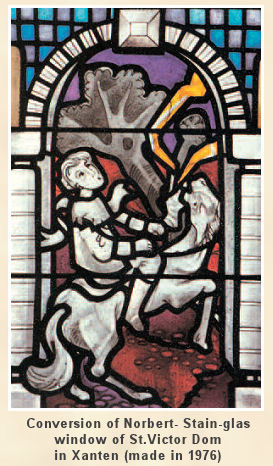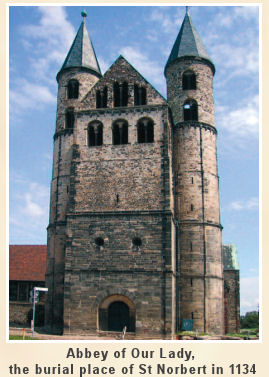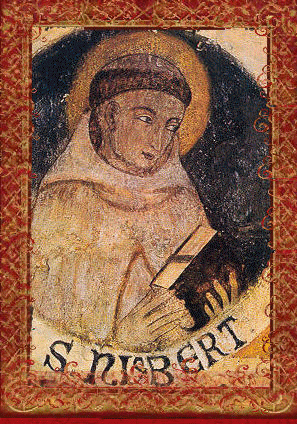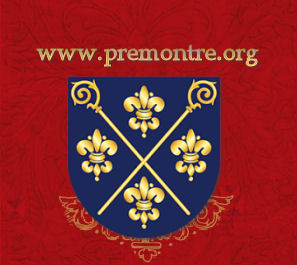
 St Norbert was born of noble parents around the year 1080 in Xanten (northern Rhineland). As the second son of the Lord of Gennep, he became a Canon of Xanten. He made a comfortable income from this, but he did not sing in the choir; he asked somebody else to do it. He was very talented, so Emperor Henry V soon recognized Norbert`s gifts and charm and called him into his personal service at the imperial court. In the year 1115 Norbert was thrown from his horse by a thunder clap, just like St. Paul. This point of his life we call his conversion. He renounced his appointment at Court and returned to Xanten to lead a life of penance, placing himself under the direction of Cono, Abbot of St Sigeberg, near Cologne.
St Norbert was born of noble parents around the year 1080 in Xanten (northern Rhineland). As the second son of the Lord of Gennep, he became a Canon of Xanten. He made a comfortable income from this, but he did not sing in the choir; he asked somebody else to do it. He was very talented, so Emperor Henry V soon recognized Norbert`s gifts and charm and called him into his personal service at the imperial court. In the year 1115 Norbert was thrown from his horse by a thunder clap, just like St. Paul. This point of his life we call his conversion. He renounced his appointment at Court and returned to Xanten to lead a life of penance, placing himself under the direction of Cono, Abbot of St Sigeberg, near Cologne.  In gratitude to Cono, Norbert founded the Abbey of Fürstenberg, endowed it with a portion of his property, and made it over to Cono of Siegburg and his Benedictine successors before being ordained.
In gratitude to Cono, Norbert founded the Abbey of Fürstenberg, endowed it with a portion of his property, and made it over to Cono of Siegburg and his Benedictine successors before being ordained.
He was ordained to the diaconate and priesthood on the same day. After this he went back to the Canons of Xanten and tried to convert them back to the strict rules of the Canons, but unfortunately he was not successful. Norbert received permission from Pope Gelasius II to become an itinerant preacher. He went out to preach to the people (bare-footed) in a habit made of rough wool.
Norbert followed the life of the apostles. In this way he tried to fill the gap between the Christian populace and those monks living a distance from the people; and also the gap between the poor Christian folk and the rich Canons Regular who had turned away from the people.
Pope Callixtus II and Bishop Bartholomew encouraged him to settle and found a Community in Premontre, in northern France, near Laon. This new community combined the contemplative lifestyle of the Cistercian monks with Norbert’s apostolic activity. They called themselves Praemonstratensians (they also have other names today: Norbertines and White Canons).

 St. Norbert built his monasteries in the towns or busy areas, because the centre of their life was not the Abbey or Monastery, but the `open church` and the festive Liturgy, that was celebrated in these churches. The Liturgy was not based on the rite of the monks, but on the more festive diocesan liturgy that was used in large Cathedrals.
St. Norbert built his monasteries in the towns or busy areas, because the centre of their life was not the Abbey or Monastery, but the `open church` and the festive Liturgy, that was celebrated in these churches. The Liturgy was not based on the rite of the monks, but on the more festive diocesan liturgy that was used in large Cathedrals.
They chose the Rule of St. Augustine as the guiding light for the new Community. This was the rule of the priests living around their Bishop in the community.
 St. Norbert and his companions, known now as Canons Regular were well aware that preaching the Word of God was an integral part of their vocation. He chose white for their habit, which was made of rough wool, to signify angels and retained the cape or mocetum to show they were Canons. With this, Norbert was offering his disciples a symbol that constantly reminded them of their mission. This symbolism was easily understood and acknowledged by all.
St. Norbert and his companions, known now as Canons Regular were well aware that preaching the Word of God was an integral part of their vocation. He chose white for their habit, which was made of rough wool, to signify angels and retained the cape or mocetum to show they were Canons. With this, Norbert was offering his disciples a symbol that constantly reminded them of their mission. This symbolism was easily understood and acknowledged by all.
 "Welcoming the poor and pilgrims - now called hospitality- was a part of a great Canonical tradition. It was a work of mercy par excellence in an age when pilgrimage was regarded as a consecrated state of life, and travel conditions were particularly difficult. Many of Norbert`s first companions died on the road exhausted by the hardship of winter. Norbert was especially fond of this ministry of charity. He had a hospice (xenodochium) built at Premontre and found the means to see that it was properly equipped. The hospice was a complex institution: an inn for travellers, a shelter for the poor and a hospital for the sick. The Canons took care of the men, and the sisters took care of the women. From the very beginning of the Order, Blessed Ricvera of Clastres ran the hospice for her entire life and wished to be buried in the cemetery for the poor whom she had served with such selfless devotion. Later the hospice was moved to Quentin".
"Welcoming the poor and pilgrims - now called hospitality- was a part of a great Canonical tradition. It was a work of mercy par excellence in an age when pilgrimage was regarded as a consecrated state of life, and travel conditions were particularly difficult. Many of Norbert`s first companions died on the road exhausted by the hardship of winter. Norbert was especially fond of this ministry of charity. He had a hospice (xenodochium) built at Premontre and found the means to see that it was properly equipped. The hospice was a complex institution: an inn for travellers, a shelter for the poor and a hospital for the sick. The Canons took care of the men, and the sisters took care of the women. From the very beginning of the Order, Blessed Ricvera of Clastres ran the hospice for her entire life and wished to be buried in the cemetery for the poor whom she had served with such selfless devotion. Later the hospice was moved to Quentin".
(Bernard Ardura: the Order of Premontre, History and Spirituality, later:
Norbert is pictured with the double ranged staff and palladium of an Archbishop and with a chalice or monstrance which depicts his Eucharist-centered spirituality. It was the reforming, pacifying and civilizing influence of St. Norbert, combined with the zeal he inspired, that resulted in the creation of almost 400 Houses of the Order throughout medieval Europe. Norbert attracted both men and women to his Communities with his preaching and peace-making. Six years after founding the Order, Pope Honorius II appointed him to the Archbishopric of Magdeburg.so he relinquished the leadership of the Order to Hugh Fosses. He died in Magdeburg on June 6 1134 and was canonized by Pope Gregory XIII in the year 1582. After numerous attempts his body was taken to Prague in May 1627.














 |
|  www.norbertinesisters.com
www.norbertinesisters.com